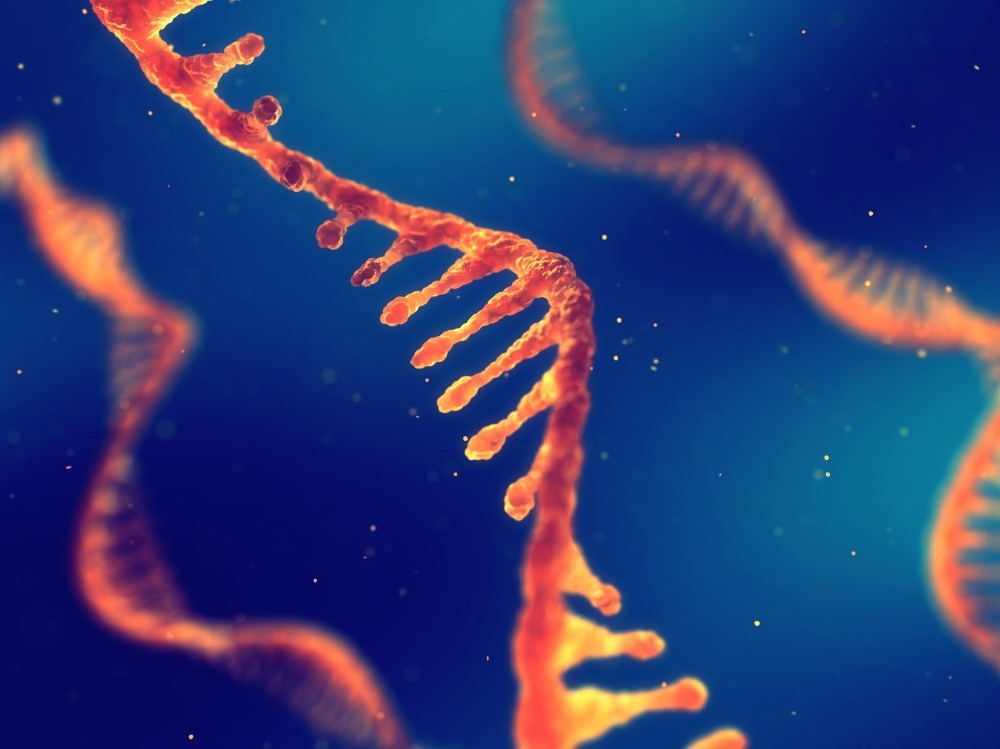Introduction
How can long non-coding RNAs be used in cancer diagnosis?
How can long non-coding RNAs be used in cancer prognosis?
How can long non-coding RNAs be used in cancer therapy?
References
Further reading
Long non-coding RNAs (lncRNA) are sections of RNA over 200 nucleotides in length that are not translated into proteins, remaining in the nucleus following transcription in relatively low concentration as compared to small non-coding, micro, small interfering, or other types of RNA. LncRNAs interact with proteins, RNA, and DNA in the cell to regulate transcription and gene expression by a number of methods, also acting as precursors to other shorter types of RNA.

Image Credit: nobeastsofierce/Shutterstock
Introduction
LncRNAs are involved in various signaling pathways. Within the disordered genome of cancer cells, these pathways may be up or downregulated, the lncRNA potentially acting as an oncogene or tumor suppressor. Importantly, strongly expressed lncRNA can be detected in peripheral blood or tissue samples and can be useful as a cancer biomarker in diagnosis and prognosis.
As lncRNA are involved in various cellular processes, a complete understanding of their function and activity also has implications for the development of cancer therapeutics, where control of lncRNA expression and function could be exploited to eliminate or suppress tumors.
The advancement of high-throughput gene sequencing technology in recent decades has provided abundant information on lncRNA and its possible roles in cancer development. Though only a small number are currently well understood enough to be investigated in clinical trials, fewer still presently being exploited in the clinic. The function and diagnostic, prognostic, and therapeutic applicability of various lncRNAs will be discussed in more detail below.
How can long non-coding RNAs be used in cancer diagnosis?
A number of specific lncRNAs have been identified as potential diagnostic biomarkers indicative of particular types of cancer. In some cases, multiple types of cancer have been found to cause the overexpression of the same lncRNAs. One of the most widely utilized lncRNA biomarkers is PCA3, the expression of which is upregulated 60 – 100-fold in 95% of prostate cancers. Usefully, heightened PCA3 expression can be observed in urine samples. However, the biomarker is not useful in differentiating between benign and malignant tumors; thus, other biomarkers are usually simultaneously probed.
Another lncRNA biomarker commonly investigated during breast cancer diagnosis is H19, where patients show elevated levels in circulating blood plasma with very high sensitivity. H19 is related to a large number of important signaling miRNAs with regard to the cellular response to cancer. It is also a precursor to oncogenic miR-675, which contributes to resistance to apoptosis and increased cellular proliferation, also a useful cancer biomarker in its own right.

Image Credit: Lightspring/Shutterstock
Interestingly, H19 is also a useful biomarker in diagnosing gastric cancer in combination with other lncRNA biomarkers HOX transcript antisense intergenic RNA (HOTAIR) and metastasis associated lung adenocarcinoma transcript 1 (MALAT1), and differences in expression levels between each biomarker can be useful in prognosis. Differences in H19 RNA sequence between individuals in the form of single nucleotide polymorphisms can also indicate cancer risk, where particular genotypes have been associated with a decreased risk of bladder cancer.
How can long non-coding RNAs be used in cancer prognosis?
The concentration of biomarker lncRNAs in the blood or urine can indicate cancer stage and progression and, therefore, present utility in predicting disease outcomes. However, as discussed, many biomarkers cannot indicate whether a tumor is benign without also investigating other associated markers, and the presence and concentration of a variety of biomarkers are considered during prognosis.
The aforementioned HOTAIR and MALAT1 lncRNAs may be upregulated in various cancers, though their presence and genotype may further indicate the state and progression of disease in specific cancers. For example, in gastric cancers, the presence of HOTAIR in the blood is associated with peritoneal diffusion and suggests cancer metastasis, predicting lower overall survival.
Similarly, high MALAT1 expression generally indicates poor prognosis in many cancers, with the progression of some, such as hepatocellular carcinoma, closely linked to MALAT1 expression. In contrast, the role of this biomarker in other cancers, such as breast, is less clear. In some cases, MALAT1 interacts with miR-1 and CDC42 to enhance cell migration, while other researchers have reported that the lncRNA acts as a suppressor of metastasis by preventing transcription factor TEAD binding with co-activating proteins.
How can long non-coding RNAs be used in cancer therapy?
The diverse involvement of lncRNAs in a variety of cellular processes makes them promising targets for cancer therapy, either through the promotion or inhibition of their transcription. For example, where a lncRNA is found to enhance tumor metastasis, a strand of RNA antisense to the lncRNA can be produced that strongly binds with and disables it.

Image Credit: ART-ur/Shutterstock
However, as lncRNA is generally functionally present in the nucleus of cancer cells, delivery of intact antisense strands to this location poses an issue. Delivery of sensitive RNA strands directly to the nucleus using nanoparticle delivery vehicles has been achieved broadly for shorter mRNA strands in research and the clinic. Similar methods have shown success for the much larger lncRNA, generally utilizing liposomal delivery vehicles capable of crossing the cell membrane directly to release their cargo into the cytoplasm in close proximity to the nucleus.
lncRNA expression may also be eliminated using gene editing technology such as CRISPR/Cas9, silencing expression directly at the genomic level. However, owing to overlapping loci with neighboring genes CRISPR/Cas9 silencing can reportedly cause a severe negative impact to their expression.
Further, a targeting mechanism highly specific to the cancer cell must be utilized to ensure minimal off-target effects, i.e., systemic shutdown of lncRNA production is not desired. Again, nanoparticle delivery vehicles carrying targeting ligands capable of interacting with overexpressed receptors on the surface of cancer cells provide a likely solution to lncRNA specificity, where the therapeutic protein could be co-loaded to encourage its on-target delivery.
References
- Qian, Y., Shi, L. & Luo, Z. (2020). Long Non-coding RNAs in Cancer: Implications for Diagnosis, Prognosis, and Therapy. Frontiers in Medicine, 7.
- Zhang, Y., Chen, X., Lin, J., & Jin, X. (2021). Biological functions and clinical significance of long non-coding RNAs in bladder cancer. Cell Death Discovery, 7(1). https://doi.org/10.1038/s41420-021-00665-z
- Liu, Y., Ding, W., Yu, W., Zhang, Y., Ao, X., & Wang, J. (2021). Long non-coding RNAs: Biogenesis, functions, and clinical significance in gastric cancer. Molecular Therapy - Oncolytics, 23, 458–476. https://doi.org/10.1016/j.omto.2021.11.005
Further Reading